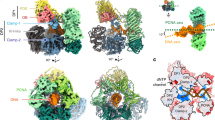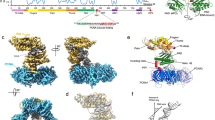Abstract
DNA synthesis by classical polymerases can be blocked by many lesions. These blocks are overcome by translesion synthesis, whereby the stalled classical, replicative polymerase is replaced by a nonclassical polymerase. In eukaryotes this polymerase exchange requires proliferating cell nuclear antigen (PCNA) monoubiquitination. To better understand the polymerase exchange, we developed a means of producing monoubiquitinated PCNA, by splitting the protein into two self-assembling polypeptides. We determined the X-ray crystal structure of monoubiquitinated PCNA and found that the ubiquitin moieties are located on the back face of PCNA and interact with it through their canonical hydrophobic surface. Moreover, the attachment of ubiquitin does not change PCNA's conformation. We propose that PCNA ubiquitination facilitates nonclassical polymerase recruitment to the back of PCNA by forming a new binding surface for nonclassical polymerases, consistent with a 'tool belt' model of the polymerase exchange.
This is a preview of subscription content, access via your institution
Access options
Subscribe to this journal
Receive 12 print issues and online access
$189.00 per year
only $15.75 per issue
Buy this article
- Purchase on Springer Link
- Instant access to full article PDF
Prices may be subject to local taxes which are calculated during checkout






Similar content being viewed by others
References
Prakash, S., Sung, P. & Prakash, L. DNA-repair genes and proteins of Saccharomyces cerevisiae. Annu. Rev. Genet. 27, 33–70 (1993).
Jentsch, S., McGrath, J.P. & Varshavsky, A. The yeast DNA-repair gene Rad6 encodes a ubiquitin-conjugating enzyme. Nature 329, 131–134 (1987).
Bailly, V., Lamb, J., Sung, P., Prakash, S. & Prakash, L. Specific complex-formation between yeast Rad6 and Rad18 proteins—a potential mechanism for targeting Rad6 ubiquitin-conjugating activity to DNA-damage sites. Genes Dev. 8, 811–820 (1994).
Bailly, V., Lauder, S., Prakash, S. & Prakash, L. Yeast DNA repair proteins Rad6 and Rad18 form a heterodimer that has ubiquitin conjugating, DNA binding, and ATP hydrolytic activities. J. Biol. Chem. 272, 23360–23365 (1997).
Hoege, C., Pfander, B., Moldovan, G.L., Pyrowolakis, G. & Jentsch, S. RAD6-dependent DNA repair is linked to modification of PCNA by ubiquitin and SUMO. Nature 419, 135–141 (2002).
Stelter, P. & Ulrich, H.D. Control of spontaneous and damage-induced mutagenesis by SUMO and ubiquitin conjugation. Nature 425, 188–191 (2003).
Broomfield, S., Chow, B.L. & Xiao, W. MMS2, encoding a ubiquitin-conjugating-enzyme-like protein, is a member of the yeast error-free postreplication repair pathway. Proc. Natl. Acad. Sci. USA 95, 5678–5683 (1998).
Hofmann, R.M. & Pickart, C.M. Noncanonical MMS2-encoded ubiquitin-conjugating enzyme functions in assembly of novel polyubiquitin chains for DNA repair. Cell 96, 645–653 (1999).
Ulrich, H.D. & Jentsch, S. Two RING finger proteins mediate cooperation between ubiquitin-conjugating enzymes in DNA repair. EMBO J. 19, 3388–3397 (2000).
Prakash, S. & Prakash, L. Translesion DNA synthesis in eukaryotes: a one- or two-polymerase affair. Genes Dev. 16, 1872–1883 (2002).
Prakash, S., Johnson, R.E. & Prakash, L. Eukaryotic translesion synthesis DNA polymerases: specificity of structure and function. Annu. Rev. Biochem. 74, 317–353 (2005).
Nelson, J.R., Lawrence, C.W. & Hinkle, D.C. Thymine-thymine dimer bypass by yeast DNA polymerase zeta. Science 272, 1646–1649 (1996).
Nelson, J.R., Lawrence, C.W. & Hinkle, D.C. Deoxycytidyl transferase activity of yeast REV1 protein. Nature 382, 729–731 (1996).
Lawrence, C.W. Cellular roles of DNA polymerase zeta and Rev1 protein. DNA Repair (Amst.) 1, 425–435 (2002).
Lawrence, C.W. Cellular functions of DNA polymerase zeta and Rev1 protein. Adv. Protein Chem. 69 (DNA Repair and Replication), 167–203 (2004).
Johnson, R.E., Prakash, S. & Prakash, L. Efficient bypass of a thymine-thymine dimer by yeast DNA polymerase, Pol eta. Science 283, 1001–1004 (1999).
Washington, M.T., Johnson, R.E., Prakash, S. & Prakash, L. Accuracy of thymine-thymine dimer bypass by Saccharomyces cerevisiae DNA polymerase eta. Proc. Natl. Acad. Sci. USA 97, 3094–3099 (2000).
Johnson, R.E., Kondratick, C.M., Prakash, S. & Prakash, L. hRAD30 mutations in the variant form of xeroderma pigmentosum. Science 285, 263–265 (1999).
Masutani, C. et al. The XPV (xeroderma pigmentosum variant) gene encodes human DNA polymerase eta. Nature 399, 700–704 (1999).
Bienko, M. et al. Ubiquitin-binding domains in Y-family polymerases regulate translesion synthesis. Science 310, 1821–1824 (2005).
Guo, C. et al. Ubiquitin-binding motifs in REV1 protein are required for its role in the tolerance of DNA damage. Mol. Cell. Biol. 26, 8892–8900 (2006).
Kannouche, P.L., Wing, J. & Lehmann, A.R. Interaction of human DNA polymerase eta with monoubiquitinated PCNA: a possible mechanism for the polymerase switch in response to DNA damage. Mol. Cell 14, 491–500 (2004).
Zhuang, Z. et al. Regulation of polymerase exchange between pol eta and pol delta by monoubiquitination of PCNA and the movement of DNA polymerase holoenzyme. Proc. Natl. Acad. Sci. USA 105, 5361–5366 (2008).
Haracska, L., Kondratick, C.M., Unk, I., Prakash, S. & Prakash, L. Interaction with PCNA is essential for yeast DNA polymerase eta function. Mol. Cell 8, 407–415 (2001).
Garg, P. & Burgers, P.M. Ubiquitinated proliferating cell nuclear antigen activates translesion DNA polymerases eta and REV1. Proc. Natl. Acad. Sci. USA 102, 18361–18366 (2005).
Haracska, L., Unk, I., Prakash, L. & Prakash, S. Ubiquitylation of yeast proliferating cell nuclear antigen and its implications for translesion DNA synthesis. Proc. Natl. Acad. Sci. USA 103, 6477–6482 (2006).
Krishna, T.S.R., Kong, X.-P., Gary, S., Burgers, P.M. & Kuriyan, J. Crystal structure of the eukaryotic DNA polymerase processivity factor PCNA. Cell 79, 1233–1243 (1994).
Hurley, J.H., Lee, S. & Prag, G. Ubiquitin-binding domains. Biochem. J. 399, 361–372 (2006).
Hicke, L., Schubert, H.L. & Hill, C.P. Ubiquitin-binding domains. Nat. Rev. Mol. Cell Biol. 6, 610–621 (2005).
Bunting, K.A., Roe, S.M. & Pearl, L.H. Structural basis for recruitment of translesion DNA polymerase Pol IV/DinB to the beta-clamp. EMBO J. 22, 5883–5892 (2003).
Indiani, C., McInerney, P., Georgescu, R., Goodman, M.F. & O′Donnell, M. A sliding-clamp tool belt binds high- and low-fidelity DNA polymerases simultaneously. Mol. Cell 19, 805–815 (2005).
Bomar, M.G., Pai, M.T., Tzeng, S.R., Li, S.S.C. & Zhou, P. Structure of the ubiquitin-binding zinc finger domain of human DNA Y-polymerase eta. EMBO Rep. 8, 247–251 (2007).
Acharya, N. et al. Roles of PCNA-binding and ubiquitin-binding domains in human DNA polymerase eta in translesion DNA synthesis. Proc. Natl. Acad. Sci. USA 105, 17724–17729 (2008).
Trincao, J. et al. Structure of the catalytic core of S-cerevisiae DNA polymerase eta: implications for translesion DNA synthesis. Mol. Cell 8, 417–426 (2001).
Alt, A. et al. Bypass of DNA lesions generated during anticancer treatment with cisplatin by DNA polymerase. Science 318, 967–970 (2007).
Hishiki, A. et al. Structural basis for novel interactions between human translesion synthesis polymerases and proliferating cell nuclear antigen. J. Biol. Chem. 284, 10552–10560 (2009).
Freudenthal, B.D., Ramaswamy, S., Hingorani, M.M. & Washington, M.T. Structure of a mutant form of proliferating cell nuclear antigen that blocks translesion DNA synthesis. Biochemistry 47, 13354–13361 (2008).
Swan, M.K., Johnson, R.E., Prakash, L., Prakash, S. & Aggarwal, A.K. Structural basis of high-fidelity DNA synthesis by yeast DNA polymerase delta. Nat. Struct. Mol. Biol. 16, 979–986 (2009).
Howell, C.A., Kondratick, C.M. & Washington, M.T. Substitution of a residue contacting the triphosphate moiety of the incoming nucleotide increases the fidelity of yeast DNA polymerase zeta. Nucleic Acids Res. 36, 1731–1740 (2008).
Pflugrath, J.W. The finer things in X-ray diffraction data collection. Acta Crystallogr. D Biol. Crystallogr. 55, 1718–1725 (1999).
Read, R.J. Pushing the boundaries of molecular replacement with maximum likelihood. Acta Crystallogr. D Biol. Crystallogr. 57, 1373–1382 (2001).
Adams, P.D. et al. PHENIX: building new software for automated crystallographic structure determination. Acta Crystallogr. D Biol. Crystallogr. 58, 1948–1954 (2002).
Collaborative Computational Project, Number 4. The CCP4 suite: programs for protein crystallography. Acta Crystallogr. D Biol. Crystallogr. 50, 760–763 (1994).
Emsley, P. & Cowtan, K. Coot: model-building tools for molecular graphics. Acta Crystallogr. D Biol. Crystallogr. 60, 2126–2132 (2004).
Blanc, E. et al. Refinement of severely incomplete structures with maximum likelihood in BUSTER-TNT. Acta Crystallogr. D Biol. Crystallogr. 60, 2210–2221 (2004).
Harel, M., Kleywegt, G.J., Ravelli, R.B.G., Silman, I. & Sussman, J.L. Crystal structure of an acetylcholinesterase–fasciculin complex: interaction of a three-fingered toxin from snake venom with its target. Structure 3, 1355–1366 (1995).
Iwata, S. et al. Complete structure of the 11-subunit bovine mitochondrial cytochrome bc(1) complex. Science 281, 64–71 (1998).
Acknowledgements
The project described was supported by award number R01GM081433 from the US National Institute of General Medical Sciences. The content is solely the responsibility of the authors and does not necessarily represent the official views of the National Institute of General Medical Sciences or the National Institutes of Health. We thank E. Cho and S. Perkins for technical assistance. We thank C. Kondratick, L. Dieckman, J. Pryor and M. Wold for discussions.
Author information
Authors and Affiliations
Contributions
B.D.F. performed the biochemical and genetics experiments. B.D.F. and L.G. collected the X-ray diffraction data. B.D.F., L.G. and S.R. analyzed the X-ray diffraction data. M.T.W. supervised the study. B.D.F. and M.T.W. wrote the manuscript. All authors discussed the results and approved the manuscript.
Corresponding author
Ethics declarations
Competing interests
The authors declare no competing financial interests.
Supplementary information
Supplementary Text and Figures
Supplementary Figures 1–3 and Supplementary Table 1 (PDF 598 kb)
Rights and permissions
About this article
Cite this article
Freudenthal, B., Gakhar, L., Ramaswamy, S. et al. Structure of monoubiquitinated PCNA and implications for translesion synthesis and DNA polymerase exchange. Nat Struct Mol Biol 17, 479–484 (2010). https://doi.org/10.1038/nsmb.1776
Received:
Accepted:
Published:
Issue Date:
DOI: https://doi.org/10.1038/nsmb.1776
This article is cited by
-
Cryo-EM structure of human Pol κ bound to DNA and mono-ubiquitylated PCNA
Nature Communications (2021)
-
Site-specific ubiquitination affects protein energetics and proteasomal degradation
Nature Chemical Biology (2020)
-
Post translational modification of Parkin
Biology Direct (2017)
-
Structure of p15PAF–PCNA complex and implications for clamp sliding during DNA replication and repair
Nature Communications (2015)
-
Molecular architecture of the Ub-PCNA/Pol η complex bound to DNA
Scientific Reports (2015)



